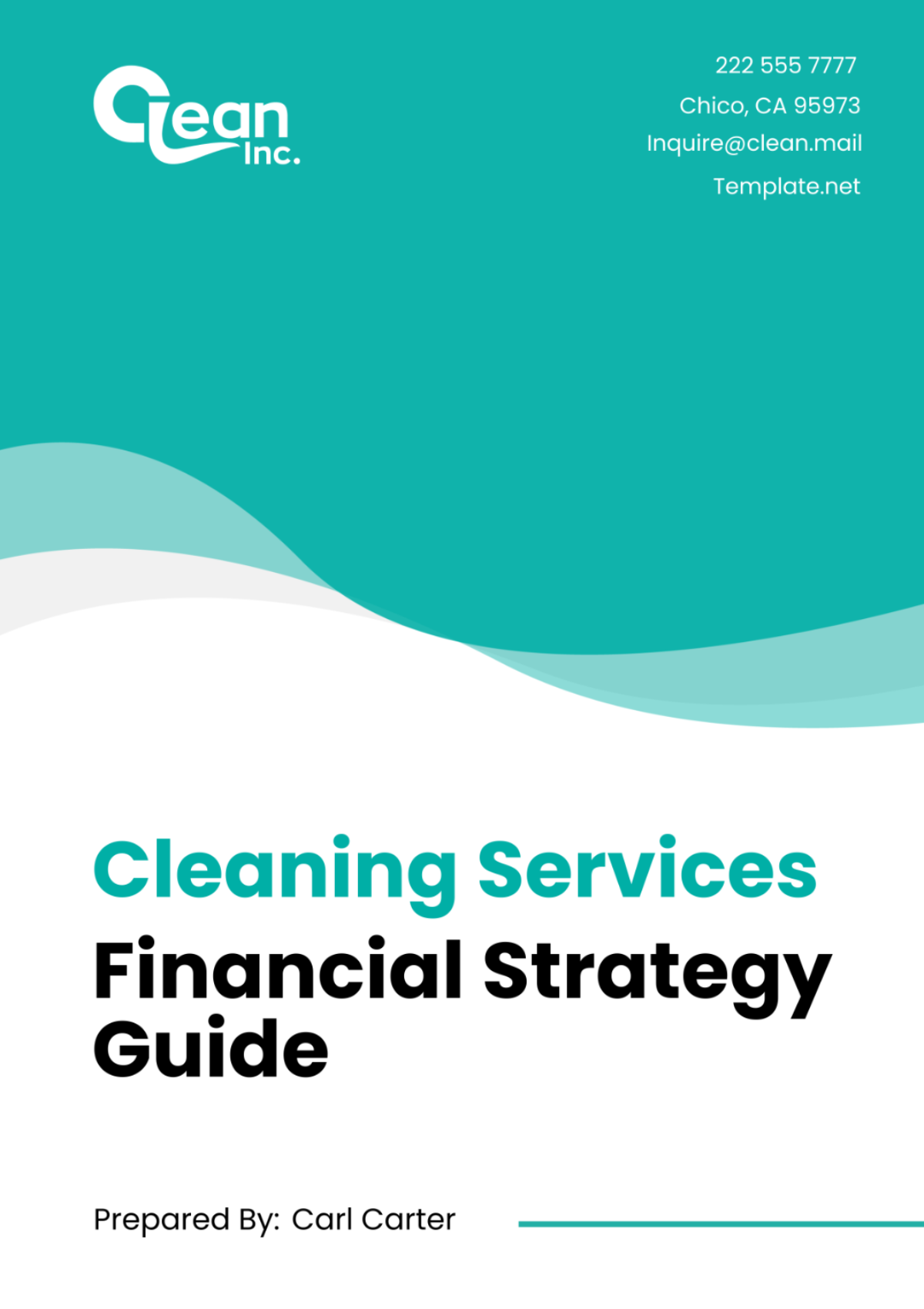Free Cleaning Services Financial Strategy Guide

I. Introduction
A. Overview
Purpose of the Financial Strategy Guide
The purpose of this Financial Strategy Guide is to provide a comprehensive framework for cleaning service companies to effectively manage their finances and achieve long-term sustainability and growth. By implementing sound financial practices outlined in this guide, cleaning businesses can optimize revenue generation, streamline expenses, mitigate financial risks, and make informed strategic decisions.
Importance of Financial Planning in Cleaning Services
Financial planning plays a critical role in the success of cleaning service businesses. It enables companies to forecast future financial performance, allocate resources efficiently, and navigate through economic uncertainties. With a well-defined financial strategy, cleaning services can enhance profitability, maintain liquidity, and capitalize on growth opportunities while ensuring financial stability in the face of challenges.
II. Setting Financial Goals
A. Defining Financial Objectives
Short-Term Goals
Short-term financial goals typically encompass objectives that can be achieved within a one to two-year timeframe. These goals may include:
Increasing monthly recurring revenue (MRR) by [$10,000] within the next 12 months.
Decreasing operational expenses by [15%] through cost optimization initiatives within the next fiscal year.
Long-Term Goals
Long-term financial goals focus on sustainable growth and profitability over an extended period, typically spanning three to five years or more. Examples of long-term goals for cleaning service businesses include:
Expanding market presence to [5] new geographic regions within the next five years.
Achieving a target profit margin of [20%] by implementing efficiency measures and value-added services over the next three years.
B. Key Performance Indicators (KPIs)
Revenue Targets
Revenue targets serve as benchmarks for monitoring the financial performance of cleaning service companies. Key revenue-related KPIs include:
Annual revenue growth rate (%)
Average revenue per customer ($)
Revenue contribution from repeat business (%)
KPI
Target Value
Annual Revenue Growth
[15%]
Average Revenue/Customer
[$150]
Revenue from Repeat Business
[30%]
Profit Margins
Profit margins indicate the efficiency of operations and the ability to generate profits from revenue. Common profit margin KPIs include:
Gross profit margin (%)
Net profit margin (%)
KPI
Target Value
Gross Profit Margin
[35%]
Net Profit Margin
[18%]
Customer Acquisition Cost (CAC)
CAC measures the cost incurred to acquire a new customer and is crucial for assessing the effectiveness of marketing and sales efforts.
Formula: CAC = Total Sales and Marketing Expenses / Number of New Customers Acquired
Target CAC: [$200] per new customer
III. Budgeting and Expense Management
A. Budget Allocation
Operational Expenses
Operational expenses encompass the day-to-day costs associated with running a cleaning service business. These may include labor costs, transportation expenses, cleaning supplies, equipment maintenance, and utilities. It's essential to allocate sufficient funds to cover these expenses while seeking opportunities to optimize costs and improve efficiency.
Marketing and Advertising
Marketing and advertising are crucial for attracting new customers and promoting brand awareness in the competitive cleaning services industry. Budget allocation for marketing efforts should consider various channels such as digital marketing, print advertising, social media promotion, and referral programs. Tracking the return on investment (ROI) for different marketing initiatives helps in optimizing spending and maximizing customer acquisition.
Staffing Costs
Staffing costs represent a significant portion of the expenses for cleaning service companies. This includes wages, benefits, training expenses, and payroll taxes for cleaners, supervisors, administrative staff, and management personnel. Proper workforce management and scheduling practices can help control labor costs while ensuring quality service delivery.
Equipment and Supplies
Investing in high-quality cleaning equipment and supplies is essential for maintaining service standards and efficiency. Budget allocation for equipment should account for the purchase, maintenance, and replacement costs of vacuum cleaners, mops, cleaning solutions, and other tools necessary for the job. Negotiating bulk discounts with suppliers and exploring eco-friendly alternatives can help manage expenses in this category.
IV. Revenue Generation Strategies
A. Diversification of Services
Residential Cleaning
Residential cleaning services cater to homeowners and tenants seeking regular or occasional cleaning of their living spaces. By offering a range of services such as deep cleaning, move-in/out cleaning, and post-renovation cleaning, cleaning service businesses can attract a diverse clientele and increase revenue streams.
Commercial Cleaning
Commercial cleaning services target businesses, office buildings, retail establishments, and other commercial properties in need of regular maintenance and sanitation. Tailoring services to meet the unique needs of different industries, such as healthcare facilities, restaurants, and corporate offices, can enhance market competitiveness and profitability.
Specialized Cleaning
Services Specialized cleaning services address niche markets and specific cleaning requirements beyond standard janitorial tasks. Examples include carpet and upholstery cleaning, window washing, floor care and restoration, and janitorial services for events and post-construction sites. Offering specialized services allows cleaning companies to command higher prices and differentiate themselves from competitors.
B. Pricing Strategies
Competitive Analysis
Conducting a thorough analysis of competitors' pricing models and service offerings helps cleaning service businesses position themselves effectively in the market. Pricing strategies should consider factors such as service quality, geographic location, target customer demographics, and competitive landscape to determine optimal pricing levels that balance profitability and market competitiveness.
Value-Based Pricing
Value-based pricing involves setting prices based on the perceived value of services to customers rather than solely on cost considerations. By emphasizing the unique benefits, reliability, and convenience of their services, cleaning companies can justify premium pricing and capture value from customers who prioritize quality and reliability over price.
Discount and Promotion
Strategies Offering discounts, promotions, and loyalty incentives can stimulate demand, attract new customers, and encourage repeat business. However, it's essential to implement discounts strategically to avoid eroding profitability and devaluing the brand. Timing promotions during seasonal peaks, offering referral discounts, and bundling services can effectively drive sales while maintaining profitability.
Pricing Strategy
Implementation
Competitive Analysis
Study competitors' pricing models and adjust accordingly.
Value-Based Pricing
Emphasize unique value propositions to justify premium pricing.
Discount Strategies
Implement targeted promotions and loyalty incentives.
Discount Strategy
Implementation
Seasonal Discounts
Offer discounted rates during off-peak seasons to stimulate demand.
Referral Discounts
Provide discounts to customers who refer new business.
Bundle Discounts
Combine multiple services into packages at discounted rates.
V. Financial Risk Management
A. Insurance Coverage
Liability Insurance
Liability insurance protects cleaning service businesses from potential lawsuits and claims arising from property damage, bodily injury, or other liabilities related to their operations. Policies may include general liability insurance, professional liability (errors and omissions) insurance, and umbrella liability coverage to provide comprehensive protection against legal risks.
Workers' Compensation
Workers' compensation insurance is essential for cleaning companies with employees as it provides coverage for medical expenses, lost wages, and disability benefits in the event of work-related injuries or illnesses. Compliance with state-specific workers' compensation regulations is necessary to protect employees and mitigate financial liabilities for the business.
B. Emergency Fund Planning
Setting Aside Reserves
Building an emergency fund is critical for cleaning service businesses to prepare for unexpected expenses, revenue fluctuations, or business interruptions. Financial reserves should be sufficient to cover essential operating costs, such as payroll, rent, utilities, and insurance premiums, for a designated period, typically three to six months.
Contingency Planning for Unforeseen Circumstances
Developing contingency plans helps cleaning companies respond effectively to unforeseen events such as natural disasters, economic downturns, or public health emergencies. Contingency planning involves identifying potential risks, assessing their impact on business operations, and implementing proactive measures to mitigate disruptions and minimize financial losses.
VI. Investment and Growth Opportunities
A. Expansion Plans
Geographic Expansion
Geographic expansion involves entering new markets or expanding service coverage to capitalize on growth opportunities in underserved areas. Expansion strategies may include opening branch offices, franchising, forming strategic partnerships, or acquiring existing cleaning businesses to accelerate market penetration and revenue growth.
Service Portfolio Expansion
Diversifying service offerings allows cleaning service businesses to meet evolving customer demands and tap into new revenue streams. Expansion into complementary services such as landscaping, pest control, property maintenance, or janitorial supply distribution can enhance competitiveness and increase cross-selling opportunities.
B. Investment in Technology
Automation Solutions
Investing in automation technologies such as scheduling software, invoicing systems, and robotic cleaning equipment can streamline operations, improve efficiency, and reduce labor costs for cleaning businesses. Automation solutions automate repetitive tasks, enhance service delivery consistency, and free up valuable time for business owners to focus on strategic growth initiatives.
CRM Systems for Customer Management
Customer Relationship Management (CRM) systems enable cleaning companies to manage customer interactions, track leads, and nurture client relationships effectively. CRM software facilitates personalized communication, customer feedback management, and data-driven decision-making to enhance customer satisfaction, retention, and lifetime value.
Investment in Technology
Benefits
Automation Solutions
Streamline operations, reduce labor costs, improve efficiency.
CRM Systems
Enhance customer management, increase retention, and satisfaction.
VII. Financial Reporting and Analysis
A. Monthly Financial Statements
Income Statement
The income statement provides a snapshot of a cleaning service company's financial performance over a specific period, typically on a monthly basis. It details the revenues generated, expenses incurred, and net income or loss resulting from operations. Key components of the income statement include:
Revenue: Total income generated from cleaning services rendered.
Expenses: Breakdown of operating expenses such as labor costs, supplies, utilities, and overhead expenses.
Net Income: The difference between total revenue and total expenses, indicating the profitability of the business for the period.
Balance Sheet
The balance sheet presents the financial position of a cleaning service business at a specific point in time, typically at the end of the month. It provides a summary of the company's assets, liabilities, and shareholders' equity. Key components of the balance sheet include:
Assets: Resources owned by the company, including cash, accounts receivable, equipment, and property.
Liabilities: Debts and obligations owed by the company, such as accounts payable, loans, and accrued expenses.
Shareholders' Equity: The difference between total assets and total liabilities, representing the owners' residual interest in the company's assets.
Cash Flow Statement
The cash flow statement tracks the inflows and outflows of cash within a cleaning service business during a specific period, typically on a monthly basis. It categorizes cash flows into operating activities, investing activities, and financing activities to provide insights into the company's liquidity and cash management. Key components of the cash flow statement include:
Operating Activities: Cash flows from core business operations, including receipts from customers and payments to suppliers and employees.
Investing Activities: Cash flows related to the purchase or sale of assets, such as equipment, property, and investments.
Financing Activities: Cash flows from borrowing, lending, and equity transactions, including loan proceeds, repayments, and dividends paid to shareholders.
B. Performance Analysis
Variance Analysis
Variance analysis compares actual financial performance against budgeted or forecasted figures to identify discrepancies and analyze the reasons behind them. By analyzing variances in revenue, expenses, and key performance indicators, cleaning service businesses can identify areas of improvement, make informed decisions, and adjust their financial strategies accordingly.
Trend Analysis
Trend analysis involves tracking financial data over time to identify patterns, trends, and key performance indicators' trajectory. By analyzing trends in revenue, expenses, profitability ratios, and other financial metrics, cleaning service businesses can assess their financial health, monitor progress towards goals, and identify emerging opportunities or challenges for proactive management.
VIII. Conclusion
A. Summary of Key Points
In conclusion, effective financial management is essential for the success and sustainability of cleaning service businesses. By setting clear financial goals, implementing sound budgeting and expense management practices, managing financial risks, and leveraging growth opportunities, cleaning companies can enhance profitability, achieve long-term growth, and maintain financial stability in a competitive market landscape.
B. Encouragement for Implementation of Financial Strategies
We encourage cleaning service businesses to proactively implement the financial strategies outlined in this guide and continually monitor and adapt their financial plans in response to changing market conditions, customer needs, and business performance. By prioritizing financial health and adopting a strategic approach to financial management, cleaning companies can position themselves for success and thrive in the dynamic cleaning services industry.
- 100% Customizable, free editor
- Access 1 Million+ Templates, photo’s & graphics
- Download or share as a template
- Click and replace photos, graphics, text, backgrounds
- Resize, crop, AI write & more
- Access advanced editor
Discover the Cleaning Services Financial Strategy Guide Template on Template.net. This editable and customizable guide offers comprehensive insights into developing a robust financial strategy for your cleaning business. From budget allocation to revenue optimization techniques, equip yourself with the knowledge and tools necessary to ensure financial stability and growth. Editable in our Ai Editor Tool, tailor the guide to fit your company's specific needs and goals. Take charge of your cleaning service's finances and drive success with this invaluable template.





























